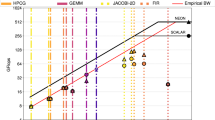Abstract
The Cell Broadband Engine (Cell BE) is a heterogeneous chip-multiprocessor (CMP) architecture to offer very high performance, especially on game and multimedia applications. The singularity of its architecture, nine cores of two different types, along with the variety of synchronization and communication primitives offered to programmers, make the task of developing efficient applications very challenging. This situation gets even worse when dual Cell-based blade platforms are considered, where two separate Cells can be linked together through a dedicated high-speed interface. In this work, we present a characterization of the main synchronization and communication primitives provided to programmers in the context of a dual Cell-based blade under varying workloads through our CellStats tool. In particular, we focus on the DMA transfer mechanism, the mailboxes, the signals, the read-modify-write atomic operations, and the time taken by thread creation. Our performance results expose the bottlenecks and asymmetries of these platforms, which must be taken into account by programmers for choosing the most adequate primitives to improve the efficiency of their applications.
Similar content being viewed by others
References
Agarwal V, Hrishikesh M, Keckler SW, Burger D (2000) Clock rate versus IPC: the end of the road for conventional microarchitectures. In: Proceedings of the 27th international symposium on computer architecture, Vancouver, British Columbia, Canada
Kanter D Intels next generation microarchitecture unveiled. Real World Technologies
Kanter D Inside Barcelona: AMDs next generation. Real World Technologies
Le HQ, Starke WJ, Fields JS, OConnell FP, Nguyen DQ, Ronchetti BJ, Sauer WM, Schwarz EM, Vaden MT. IBM POWER6 Microarchitecture. IBM J Res Dev 51(6)
Kanter D Niagara II: the hydra returns. Real World Technologies
Team IBG Overview of the IBM blue gene/P project. IBM J Res Dev
Kahle J, Day M, Hofstee H, Johns C, Maeurer T, Shippy D (2005) Introduction to the Cell multiprocessor. IBM J Res Dev 49(4/5):589–604
Ainsworth TW, Pinkston TM (2007) Characterizing the Cell EIB on-chip network. IEEE Micro 27(5):6–14
Abellán JL, Fernández J, Acacio ME (2008) Characterizing the basic synchronization and communication operations in dual cell-based blades. In: Proceedings of the 8th International Conference on Computational Science, Krákow, Poland
Chen T, Raghavan R, Dale J, Iwata E (2005) Cell broadband engine architecture and its first implementation. Tech. rep.
Flachs B et al (2005) A streaming processor unit for a cell processor. In: Proceedings of international solid state circuits conference, San Fransisco, CA, USA
Gschwind M, Hofstee HP, Flachs B, Hopkins M, Watanabe Y, Yamazaki T (2006) Synergistic processing in Cell’s multicore architecture. IEEE Micro 26(2):10–24
Kistler M, Perrone M, Petrini F (2006) Cell processor interconnection network: built for speed. IEEE Micro 25(3):2–15
IBM Systems and Technology Group (2007) Cell broadband engine programming tutorial version 2.1 (March 2007)
IBM Systems and Technology Group (2008) Programming the Cell broadband engine architecture: examples and best practices. http://www.redbooks.ibm.com/redbooks/pdfs/sg247575.pdf
IBM Systems and Technology Group (2007) SPE runtime management library version 2.2 (September 2007)
IBM Systems and Technology Group (2007) C/C++ language extensions for cell BroadBand engine architecture V2.4 (March 2007)
IBM Systems and Technology Group (2007) Cell broadband engine SDK libraries version 3.0 (October 2007)
IBM Systems and Technology Group (2007) Cell broadband engine software development toolkit (SDK) installation guide version 3.0 (October 2007)
Varbanescu AL, Sips H, Ross KA, Liu Q, Natsev AP, Smith JR, Liu L-K (2009) Evaluating application mapping scenarios on the Cell-B.E. Concurr Comput Pract Experience 21(1):85–100
Gaona E, Fernández J, Acacio ME (2009) Fast and efficient synchronization and communication collective primitives for dual Cell-based blades, Tech. rep.
Schiller A, Sutmann G, Yang L (2008) A fast wavelet based implementation to calculate Coulomb potentials on the Cell/B.E. In: Proceedings of the 10th IEEE international conference on high performance computing and communications, Dalian, China
Kang S, Bader D (2008) Optimizing discrete wavelet transform on the Cell broadband engine. In: Proceedings of the 12th annual high performance embedded computing workshop, Lexington, MA
Author information
Authors and Affiliations
Corresponding author
Rights and permissions
About this article
Cite this article
Abellán, J.L., Fernández, J. & Acacio, M.E. Characterizing the basic synchronization and communication operations in Dual Cell-based Blades through CellStats. J Supercomput 53, 247–268 (2010). https://doi.org/10.1007/s11227-009-0292-7
Received:
Accepted:
Published:
Issue Date:
DOI: https://doi.org/10.1007/s11227-009-0292-7




